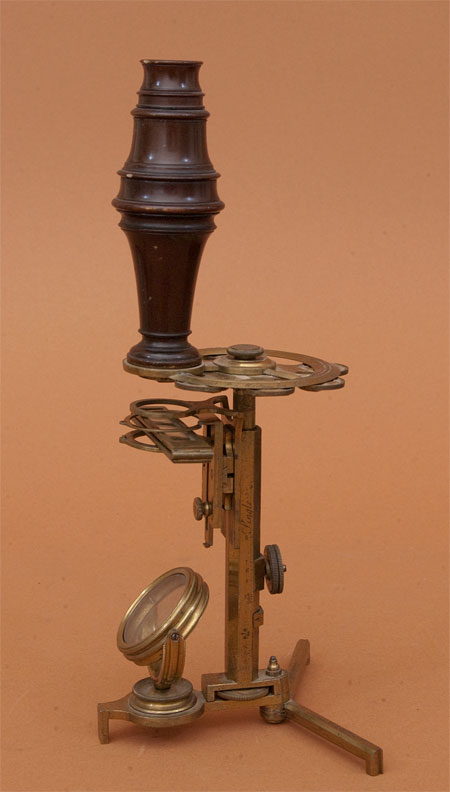 |
|||||
 |
 |
||||
 |
|||||
 |
 |
||||

Invented & Made by Geo. Adams at Tycho Brahe's Head in Fleet Street London
In designing this instrument, Adams' goal was to make a microscope that was useful for every aspect of microscopy. In Adams' words:
"It has long been the Desire of the Curious and Inquisitive Part of Mankind to have a Microscope which would be Portable and Universal, that is to say, One only Instrument by which all Sorts of minute Objects might be observed."*
This microscope is, in fact, small and portable and can be used as either a compound ("Double") microscope, or by removing the upper compound body tube, as a Single magnifier. The objective lenses are contained in an integrated rotating device that predicted the development of the rotating objective nosepiece of modern microscopes. The body tube is made of brown-stained turned ivory and contains two lenses: one biconvex eye lens and one plano-convex field lens. Either this compound microscope body or an eyecup can be screwed into a threaded mount on the top plate of the circular objective assembly. The lower rotating plate is a scalloped ring that holds the seven objective lenses (the first version of Adams' Universal microscope contained six lenses, subsequent ones had eight). Each lens is individually numbered on the surface of the circular shield-shaped objective holder. The outer rim of the top wheel is mounted to the support pillar and is maintained in position with a locating pin and single thumbscrew. The outer rim acts as a dust cover for the lenses below. To change objectives the user simply rotates the lower wheel into the desired objective position. This microscope is the first example of the use of a rotatable lens holder for the user to switch objective magnifications easily.
This instrument has both coarse and fine focus mechanisms. The entire microscope assembly is supported on two concentric central shafts (inside the octagonal pillar). Coarse focusing is established by manually sliding the outer shaft up or down inside the main pillar. Engraved position numbers on the pillar correspond to the seven possible objectives. Once aligned with an objective number, the user can then fine-focus the sample by turning a thumbscrew at the base of the pillar. Adjustment of this screw raises or lowers the inner shaft, and thus the microscope itself. The sample stage is connected to the (outer) support pillar and does not move. In later versions of Adams' Universal microscope the fine focus moved the stage relative to a fixed microscope body. In both forms the position of the fine focus control is placed at the bottom of the support pillar. In the words of G. Adams:
"This Screw is to be turned as your Hands and Arms are resting on the Table, which is a Conveniency to be met with in no other Microscope."*
This microscope can accommodate either a sample stage or a tweezer/needle specimen holder, both inserted by a fitted tongue and groove into a mount on the octagonal brass support pillar. One of three silvered Lieberkuhns can be screwed into a threaded mount fitted between the stage or specimen holder and the pillar. The support for the pillar and the mirror is a folding tripod base riveted to the support pillar.
Accessories include stage and sample forceps, two configurations of live-boxes, a black/white disc, and ivory coverslip holders. The microscope can be disassembled and stored in a wooden, ray skin covered case.
A microscope of similar design is part of the the King George III Collection now housed at the Science Museum London. This instrument in the Golub Collection is a rare and interesting example of the rapid evolutionary changes that were taking place in the mechanical construction of the microscope during the middle of the 18th century. The instrument in the Double Microscope configuration is 25cm tall.
* Adams, G. 1746. Micrographia Illustrata.
Microscope featured 10/2011